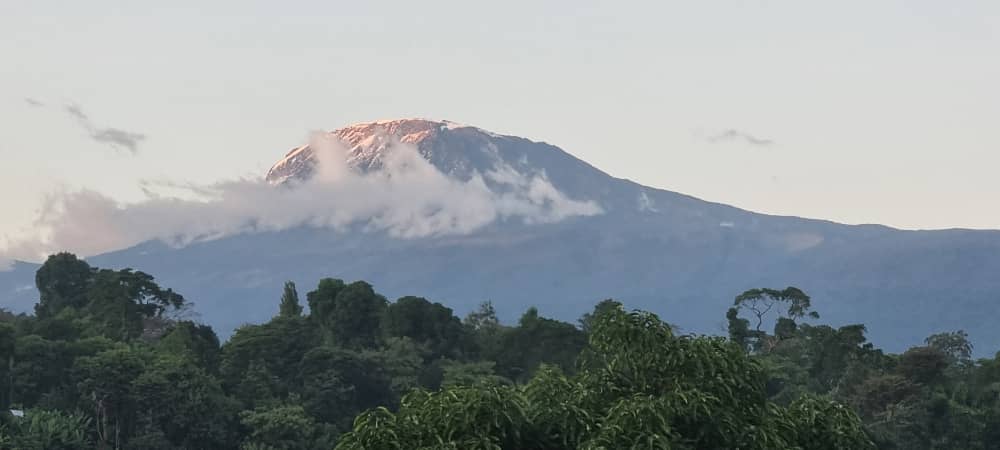MOUNT KILIMANJARO
~ THE ROOF OF AFRICA
MOUNT KILIMANJARO NATIONALPARK

From dense rainforest to alpine desert
Mount Kilimanjaro Nationalpark in northern Tanzania is home to Africa’s highest mountain. Here you can climb to the summit, go on guided hikes, watch birds and admire waterfalls. The three peaks of Kili are legendary and have formed over thousands of years. Kibo, in the centre, is the highest and youngest of the three volcanic peaks and is a dormant volcano. In the west is the oldest peak, Shira, followed by Mawenzi in the east. Both are extinct. In 1987, Kilimanjaro was declared a UNESCO World Heritage Site due to its unique geology, five vegetation zones and diverse wildlife.
Home to the highest mountain in Africa
Kilimanjaro Nationalpark is home to Africa’s highest mountain, and the highest free-standing mountain in the world. In 1987, the park was declared a UNESCO World Heritage Site due to its unique geological formation rising from the flat savannah, its diverse wildlife and various vegetation zones.
Mount Kilimanjaro consists of three peaks: Kibo (5.895 m), Shira in the west (4.269 m) and Mawenzi in the east (5.280 m). Shira and Mawenzi are extinct. Kibo was last active between 150.000 and 200.000 years ago and could theoretically awaken from its dormant phase at any time.
Vegetation in Mt Kilimanjaro Nationalpark
The vegetation of Mount Kilimanjaro is very diverse with around 2.500 plant species. Notable flowers include the endemic Impatiens Kilimanjari, a beautiful orchid-like plant, and the pretty violet Viola Eminii.
Around 140 tree species grow in the lush green belt of the mountain forests. The next vegetative zone is a heath and moorland landscape dotted with giant lobelia. An alpine desert zone stretches over 4.000 metres, looking like a lunar landscape covered in rocks and dust. From Kibo, hikers are rewarded with views of glaciers and three huge craters.
Activities
The majority of visitors to the park come with the aim of climbing Africa’s highest peak. You can find more information on our page about climbing Mount Kilimanjaro.
Besides the multi-day hike, one of the most popular ways to experience the park with its outstanding views, plants and animals is a day trip with a guided hike to the Shira Plateau .
You can spot a variety of animals on your hike. Kilimanjaro National Park is home to around 140 species of mammals, and while travelling through the mountain forests you can spot up to 87 forest-dwelling species, including the colobus monkey and the diademed monkey. Elephants, leopards, buffaloes and various antelope species, including the endangered Abbott’s duiker, also live here. In addition, there are around 179 species of highland birds and 24 species of bats.
However, hiking and flora are certainly the focus of Kilimanjaro National Park. The hike to the Shira Plateau begins at 3.500 metres. Take in the sounds, smells and colours and enjoy breathtaking views of Kibo, the vast plains of Amboseli National Park in Kenya and the deep gorge of the Simba River. You stop at the edge of the Shira Crater to marvel at the volcanic cones in the landscape. Walk at your own pace, enjoy a picnic and experience the wonders of Mount Kilimanjaro National Park.
Best time to visit Mt Kilimanjaro National Park
On your Kilimanjaro hike, you may well experience all four seasons in one day. Nevertheless, the best time to go on a Kilimanjaro National Park safari is during the dry season from June to the end of October. This is when the weather on the mountain is at its best and clouds that could impair your view are rare. Temperatures drop in the mornings and evenings and frost is common, so you should bring warm clothing. The park can theoretically also be visited during the two rainy seasons from November to December and from March to May, but the weather is unfavourable during this time.
More than just a summit hike
You are visiting Mount Kilimanjaro National Park because you want to experience this unique place with its fascinating five vegetation zones, its unique wildlife and its incredible views. It is a beautiful world heritage site.
If you’re not planning to climb the mountain, a four-hour hike to Shira Crater is the best way to enjoy the plants, landscapes, wildlife and breathtaking views.
A visit to Mount Kilimanjaro National Park is a highlight for keen photographers, the impressive scenery makes for unforgettable snapshots. Hikers, birdwatchers and nature lovers will also love this park.
Location
Kilimanjaro National Park is located on Tanzania’s northern border with Kenya. It is easily accessible as it is only about 120 km from Arusha International Airport. The most popular entrance is the Marangu Gate, about 39 km from Moshi. There are seven other gates including Londorossi, Lemosho, Kilema, Rongai, Mweka, Machame and Umbwe. Cabins and campsites are scattered throughout the park. Mkomazi Nationalpark is only 170 kilometres away and a great place to visit afterwards. There you can stay in beautiful accommodation and spot black rhino and African wild dog.
Photos from Mount Kilimanjaro Climbing












INQUIRE KILIMANJARO CLIMB TOUR
Start planning your Kilimanjaro climb by filling the form below
